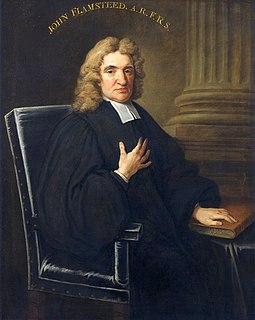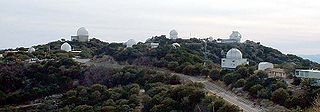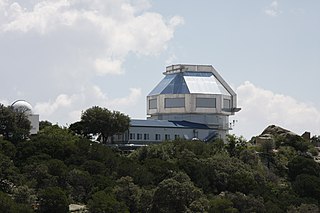Related Research Articles

Astronomer Royal is a senior post in the Royal Households of the United Kingdom. There are two officers, the senior being the Astronomer Royal dating from 22 June 1675; the second is the Astronomer Royal for Scotland dating from 1834.

The Kitt Peak National Observatory (KPNO) is a United States astronomical observatory located on Kitt Peak of the Quinlan Mountains in the Arizona-Sonoran Desert on the Tohono O'odham Nation, 88 kilometers (55 mi) west-southwest of Tucson, Arizona. With more than twenty optical and two radio telescopes, it is one of the largest gatherings of astronomical instruments in the northern hemisphere.

Gerard Peter Kuiper was a Dutch astronomer, planetary scientist, selenographer, author and professor. He is the eponymous namesake of the Kuiper belt.

Yerkes Observatory is an astronomical observatory located in Williams Bay, Wisconsin, U.S.A. It was operated by the University of Chicago Department of Astronomy and Astrophysics from its founding in 1897 to 2020. Ownership was transferred to the non-profit Yerkes Future Foundation (YFF) in May 2020, which began restoration and renovation of the historic building and grounds. Re-opening for public visits and programming is expected in 2022.

The McDonald Observatory is an astronomical observatory located near the unincorporated community of Fort Davis in Jeff Davis County, Texas, United States. The facility is located on Mount Locke in the Davis Mountains of West Texas, with additional facilities on Mount Fowlkes, approximately 1.3 kilometers (0.81 mi) to the northeast. The observatory is part of the University of Texas at Austin. It is an organized research unit of the College of Natural Sciences.

The WIYN Observatory is owned and operated by the WIYN Consortium. Its 3.5-meter telescope is the second largest optical telescope at Kitt Peak National Observatory in Arizona. Most of the capital costs for the observatory were provided by the University of Wisconsin–Madison, Indiana University, and Yale University, while the National Optical Astronomy Observatory (NOAO) provides most of the operating services. The NOAO is an institution of the United States; it is the national optical observatory program and supports a collection of ground-based telescopes at Kitt Peak as well as other locations.
Carl Keenan Seyfert was an American astronomer. He is best known for his 1943 research paper on high-excitation line emission from the centers of some spiral galaxies, which are named Seyfert galaxies after him. Seyfert's Sextet, a group of galaxies, is also named after him.

The Pegasus Dwarf Spheroidal is a dwarf spheroidal galaxy about 2.7 million light-years away in the constellation Pegasus. The Pegasus Dwarf is a member of the Local Group and a satellite galaxy of the Andromeda Galaxy (M31).

The Hale Telescope is a 200-inch (5.1 m), f/3.3 reflecting telescope at the Palomar Observatory in San Diego County, California, US, named after astronomer George Ellery Hale. With funding from the Rockefeller Foundation in 1928, he orchestrated the planning, design, and construction of the observatory, but with the project ending up taking 20 years he did not live to see its commissioning. The Hale was groundbreaking for its time, with double the diameter of the second-largest telescope, and pioneered many new technologies in telescope mount design and in the design and fabrication of its large aluminum coated "honeycomb" low thermal expansion Pyrex mirror. It was completed in 1949 and is still in active use.
Andromeda V is a dwarf spheroidal galaxy about 2.52 Mly away in the constellation Andromeda.

The Cassiopeia Dwarf (also known as Andromeda VII) is a dwarf spheroidal galaxy about 2.45 Mly away in the constellation Cassiopeia. The Cassiopeia Dwarf is part of the Local Group and a satellite galaxy of the Andromeda Galaxy (M31). In the sky, it appears behind the Milky Way's galactic plane, and so it is reddened by 0.194 magnitudes. With a luminosity of 1.8×107 L☉ and a stellar mass of 19.73×106 M☉, it is the brightest and most massive of the Andromeda Galaxy's dwarf spheroidal galaxy satellites. It also has the highest metallicity out of all of them.
Deborah Byrd is an American science journalist. She is editor-in-chief of EarthSky, which presents science news and night sky information. The website served more than 21 million users in 2019, according to Google Analytics.

Harlan James Smith was an American astronomer. He served as director of the University of Texas McDonald Observatory from 1963 to 1989, where, among other accomplishments, he initiated the construction of the Harlan J. Smith Telescope, a 2.7-meter (107-inch) reflector now bearing his name.
The Gruber Prize in Cosmology, established in 2000, is one of three international awards worth US$500,000 made by the Gruber Foundation, a non-profit organization based at Yale University in New Haven, Connecticut.

NGC 6496 is a globular cluster which is in the direction of the bulge and putative members of this subgroup, based on observations collected with the WFPC2 on board the Hubble Space Telescope. NGC 6496 was originally believed to be a member of the disc system of GC, but scientists questioned this classification. It was instead suggested that NGC 6496, together with two other clusters, NGC 6624 and NGC 6637, could be halo clusters with strongly inclined orbits. NGC 6496 lies in the Southern sky at RA=17:59:03.68 and Dec=-44:15:57.4.
Harriet Dinerstein is an American astronomer. The American Astronomical Society honored her work by awarding her the Annie J. Cannon Prize in 1985. She also received the Newton Lacy Pierce Prize in 1989. Dinerstein received her Bachelor of Science degree from Yale University in 1975 and her Ph.D. from the University of California, Santa Cruz in 1980. She currently is a Professor of Astronomy at the University of Texas at Austin.
Daniel Jaffe is an American astronomer, currently the Jane and Roland Blumberg Centennial Professor at University of Texas at Austin. He received his BA, MA, and PhD from Harvard University. He currently serves as the Interim Executive Vice President and Provost at The University of Texas at Austin. He previously served as the Vice President for Research.
John Kormendy, is an American astronomer, currently the Curtis T. Vaughn, Jr. Centennial Chair at University of Texas at Austin. He is known for the Kormendy relation found in the surface brightness profiles for elliptic galaxies.
Anita L. Cochran is an American astronomer, planetary scientist, and senior research scientist at the University of Texas at Austin. She is also the assistant director for research support at the McDonald Observatory. She focuses on the study of primitive bodies in the solar system and the composition of comets.
References
- ↑ "Faculty". utexas.edu. Retrieved December 11, 2016.
- ↑ "Taft Armandroff". iau.org. Retrieved December 11, 2016.
- ↑ "CV" (PDF). utexas.edu. Retrieved December 11, 2016.
- ↑ "Leading Astronomer Taft Armandroff Appointed Director of UT's McDonald Observatory". utexas.edu. Retrieved December 11, 2016.